In the
Forbidden City, there are many animal statues in front of the palace gates or the palaces. If looking carefully, you can even find them on the roofs, windows, columns, doors of the architecture. In Chinese culture, these are auspicious animals to ward off evil spirits, bring good fortune and luck, and pray for permanent and continuous blessing of the country. Below are some of the most famous animal statues in the Forbidden City:
The dragon is the most revered animal in China, and ancient Chinese emperors are called as the “son of dragon”, so the most frequently seen animal in the Forbidden City is dragon. For instance, the most supreme building of the whole imperial palace, Hall of Supreme Harmony (Taihedian), has 13,844 dragon patterns and dragon carvings inside and outside. And it is calculated that there are a total of over 50,000 dragons in the whole Forbidden City. Among these dragons, the 4 gilded bronze dragons on the roof of the Yuhuage Pavilion are particularly peculiar. They are 3 meters long crunching on the roof, seeming like just take a break there and would fly downward anytime. Inside the Palace of Gathered Elegance (Chuxiugong), where the Empress Dowager Cixi lived, there is also a dragon statue, implying Cixi’s ambition to replace the emperor.
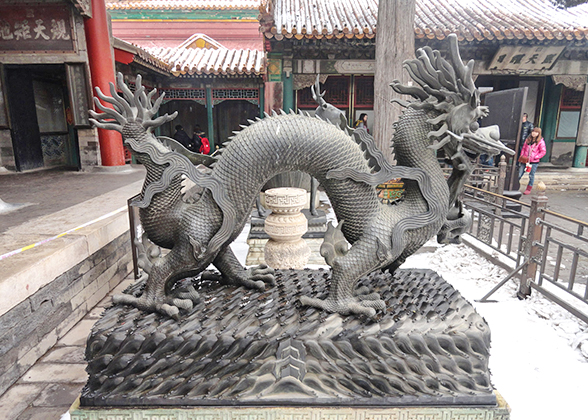 | | Dragon in Palace of Gathered Elegance | | 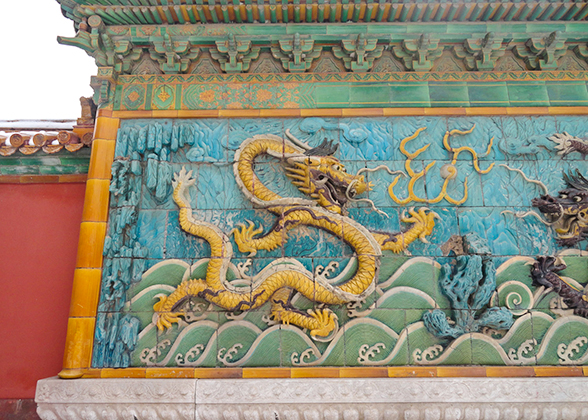 | | Nine Dragon Wall at Palace of Tranquil Longevity | |
Phoenix
In China, phoenix is the symbol of the empress. So phoenix statues can also be seen in the Forbidden City. The most famous one is the copper phoenix statue in front of the Tihedian, the dining hall for the Empress Dowager Cixi. It is tall and slim with an elegant appearance.
Lion
The lion is strong and powerful so it is often placed in front of the house or gate to ward off evil spirits and bring good luck and blessing. Lion statues are also common in the Forbidden City, with seven or eight pairs all together, which are generally a male and a female. The male's paw often presses a ball, symbolizing the unity of the world, while the female's paw presses a cub, symbolizing an endless offspring of the royal family.
The lion statues in front of the Hall of Supreme Harmony in the Forbidden City are made of bronze, with fine workmanship. They are the largest pair of bronze lions in the Forbidden City and the only pair without golden gilt. Each lion has 45 buns on its head, representing the supreme dignity of the emperor in Chinese context. The ears were pricked up, which means that the emperor should listen more to the opinions of his ministers and the instruction of the god.
The lion statues in front of the Gate of Heavenly Purity (Qianqingmen), the main gate of the Inner Court where the royal families lived, have drooping ears, which warned the concubines in the inner court to listen less and discuss less about the state affairs. It also warned officials should bow and scrape to the emperor.
There is also a pair of gilt bronze lions in front of the Palace of Tranquil Longevity (Ningshougong), where the concubines of the previous emperor lived. Their ears droop and their eyebrows cover the eyes, implying that the concubines should not interfere in politics and not listen or see those affairs.
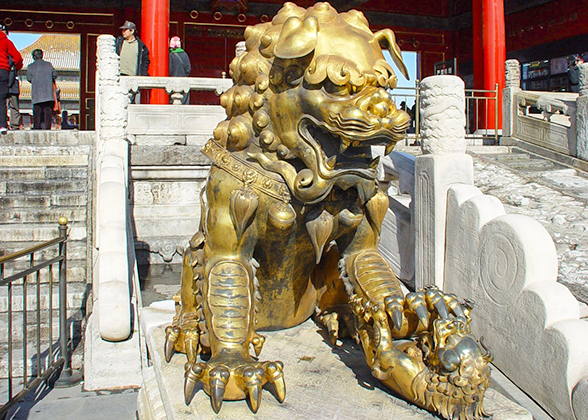 | | Female Lion in front of Taihemen | | 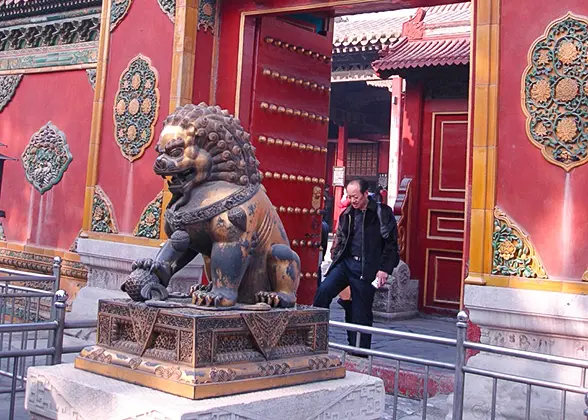 | | Male Lion in front of Hall of Mental Cultivation | |
Tortoise and Crane
In ancient times, crane and tortoise were the animals that represented longevity, so they were usually used as a pair and placed in front of the palace, together blessing the longevity of the emperor and his offspring, and the permanence of the country. In front of the Hall of Supreme Harmony, there is a pair of copper tortoise and copper crane. Their mouths are open and the heads are up towards the sky. The crane is in the front, representing the ability of soaring to the sky, and the turtle is in the back, expressing its ability to swim in the deep sea. In important ceremonies, they can also be used as incense burner, to create the effect of cloud and mist like in the heaven.
Another pair of famous tortoise and crane is in front of Palace of Heavenly Purity (Qianqinggong). The bronze crane is different from that in front of the Hall of Supreme Harmony. Its mouth is closed, with relatively flat forehead. The tail feather is shorter, and the foot is on artificial mountain as the bottom, overall more feminine and delicate. On the head of the bronze tortoise, there is a single horn, and there are several lines on both sides of the neck. The plate on its back is also different from that in front of the Hall of Supreme Harmony. The overall shape means the family’s everlasting rule over the country.
 | | Tortoise in Forbidden City | | 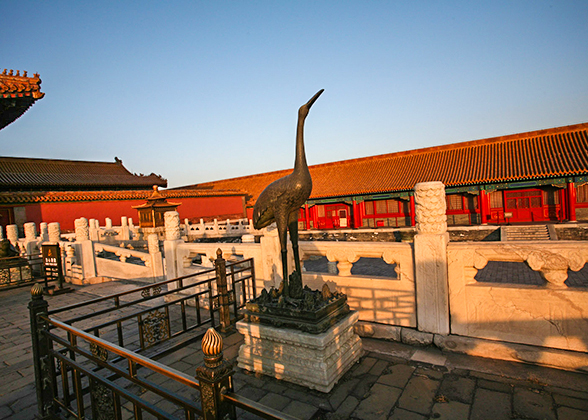 | | Crane at Hall of Supreme Harmony | |
Kirin (Qilin)
In front of the Palace of Compassion and Tranquility (Cininggong) there is a pair of gilt animals, characterized by dragon heads, two horns, four hooves and scales. They were placed in front of the Cininggong, suggesting that the concubines who had had children with the previous emperor were living here.
Haetae (Xiezhi)
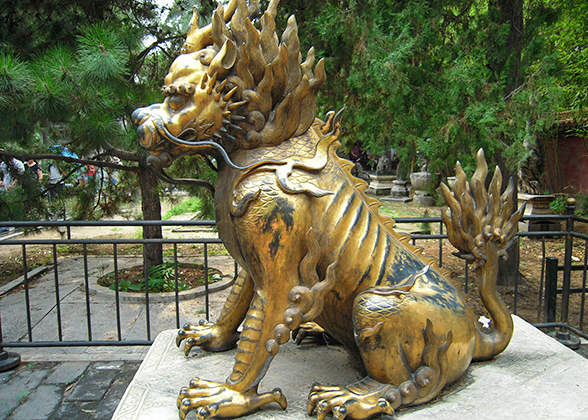 |
| Haetae (Xiezhi) in Imperial Garden |
In the Imperial Garden, there is a pair of gilt animals in front of the gate looking very similar to the gilt animals in front of Cininggong. But look closely, you will find they have single horn on their dragon head and their feet are claws instead of hooves. In Chinese culture, this animal haetae, can distinguish the rights and wrongs, and tell the goods and evils. It is said that if two people are engaged in a lawsuit or dispute, the haetae will use the horn to pierce the wrong man, so it also represents the legal justice. For ancient officials who are responsible for the supervision and judicial, their clothes are often decorated with haetae.
Elephant
There are gilt bronze elephants statues kneeling in the Imperial Garden of the Forbidden City. Strangely, their front legs are kneeling in an irregular opposite direction. Why? One saying is that the “opposite kneeling” has a homonym for “rich and auspicious” in Chinese. Another saying is that it is a symbol of imperial power. The kneeling elephant and its lowing head look just like a person kneeling on the ground, representing wholehearted obedience to the emperor.
Ridge Animals
Last but not the least, there are ridge animals on the sloping ridge of each building in the Forbidden City. There are strict rules on the size, number, and even the order of ridge animals. The number of these ridge animals is either five, seven, or nine, in a singular order. The only exception is the Hall of Supreme Harmony which has 10 ridge animals, because it is the most supreme architecture in the Forbidden City. The 10 ridge beasts contains the dragon, phoenix, lion, horse, haetae, and so on. Each has its own meaning and blessing, but all have auspicious, protective meaning, symbolizing the supremacy of the imperial power and the long run of the emperor.
 See Also: Mysterious Animals on the Palace Roofs of the Forbidden City
See Also: Mysterious Animals on the Palace Roofs of the Forbidden City
- Last updated on Sep. 25, 2024 by Gabby Li -

![]() See Also: Mysterious Animals on the Palace Roofs of the Forbidden City
See Also: Mysterious Animals on the Palace Roofs of the Forbidden City




